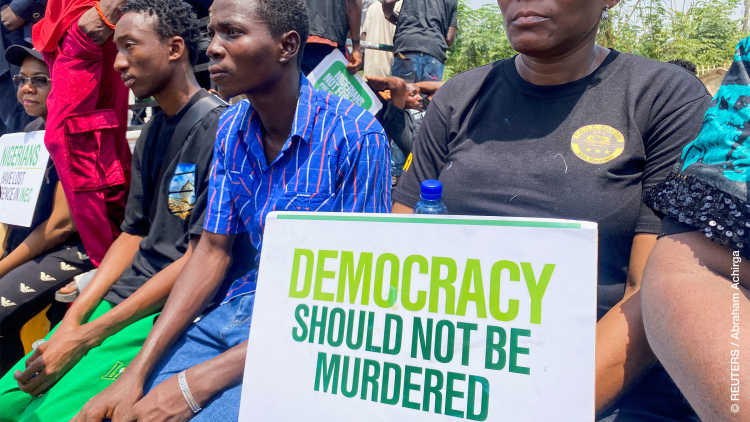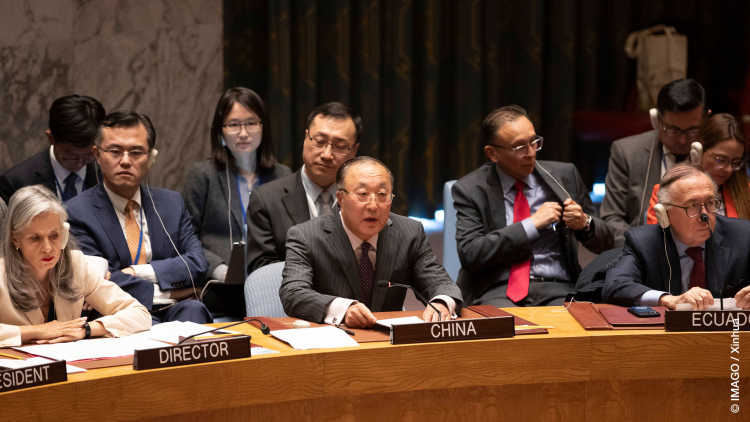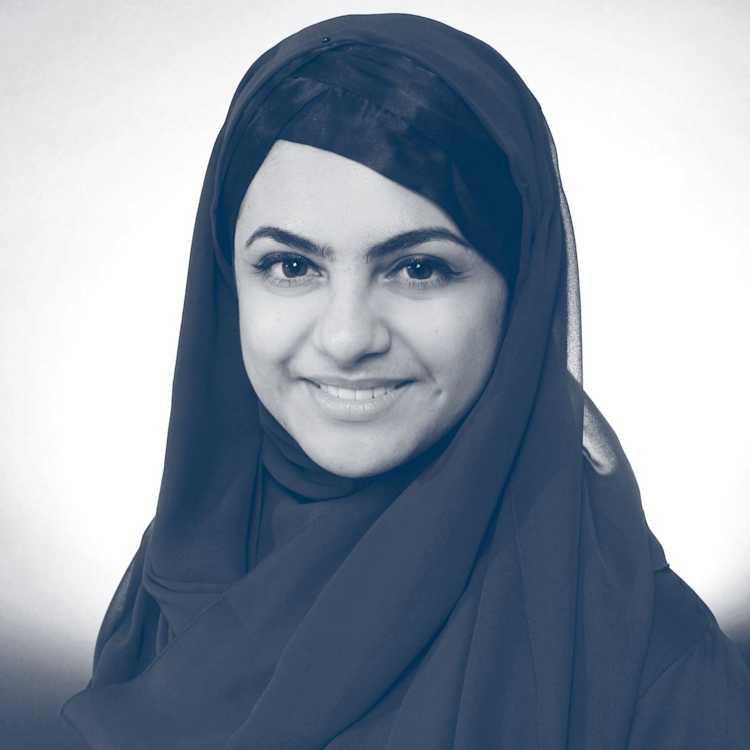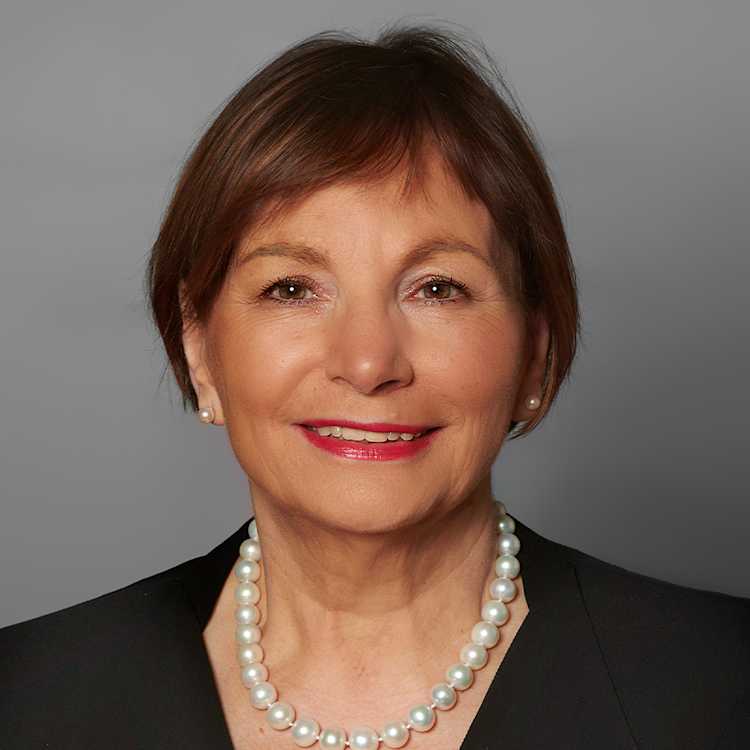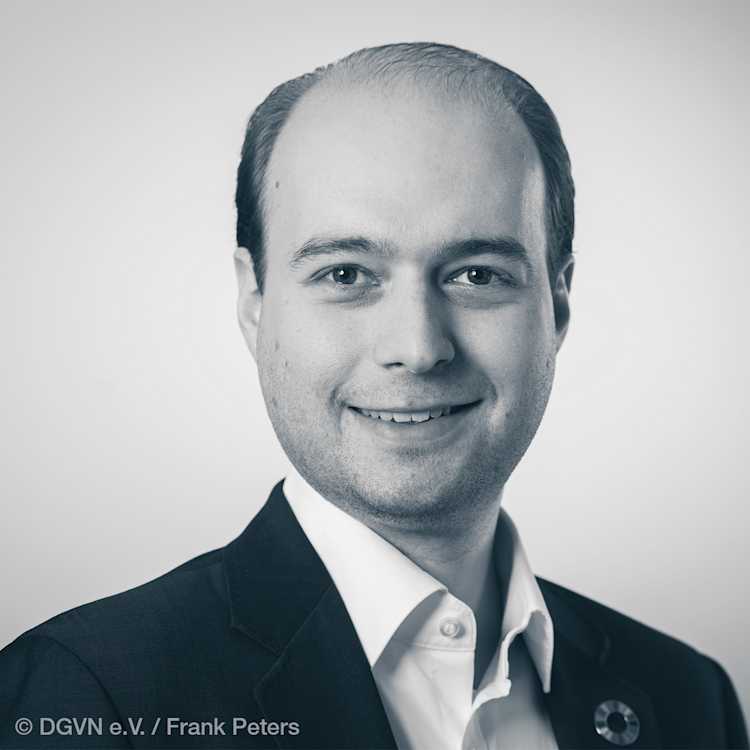- Home
- Publications
- GIGA Focus
- Converging Interests, Diverging Realities: Arab League–EU Cooperation
GIGA Focus Middle East
Converging Interests, Diverging Realities: Arab League–EU Cooperation
Number 6 | 2023 | ISSN: 1862-3611
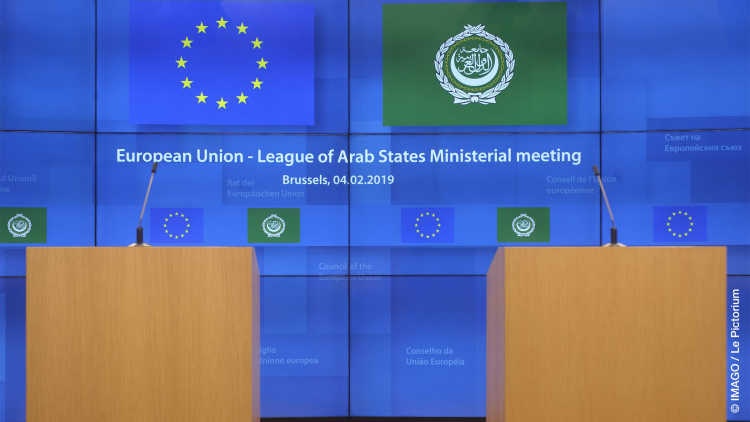
The Arab League (LAS)–European Union (EU)’s relationship is trapped in a cycle of engagement followed by distrust and failure, due to regional dynamics and a lack of resolve. Although the potential for a broad-based partnership exists, the EU's inability to act at pivotal moments, including the pressing situation in Gaza, continues to hinder meaningful collaboration between the two organisations.
The LAS–EU partnership, reinforced by shared concerns over regional crises, has been further tested by the deepening Israel–Palestine conflict, emphasising the need for a united front on humanitarian issues and peace processes.
The history of their interactions shows a pattern of initial progress followed by periods of stagnation in the face of crises, signalling a need for resilient diplomatic strategies that can break this cycle and foster more consistent collaboration.
Previous focus on security threats that are of particular concern to the EU indicates the latter's dominant role in setting the agenda. This dominance reflects underlying issues in the LAS–EU relationship, such as unbalanced power dynamics, partnerships based more on convenience than trust, and mutual misunderstandings.
Given the current critical political conditions in the region, particularly the intensifying conflict between Israel and Palestine and the indescribable humanitarian crisis in Gaza, it is crucial for both the EU and LAS to rethink their approach to collaboration. The partnership is currently fragile, threatened by potential regression or even animosity due to mistrust and misunderstanding.
Policy Implications
At this juncture, the LAS and EU need bold, urgent, substantial diplomacy and consistent dialogue channels. Prioritising regular engagement over superficial politics is key, especially to progress the Peace Process with a two-state solution. The EU must focus on enhancing the League's institutional strength, alongside addressing wider concerns beyond security to achieve meaningful results.
The Arab League and the European Union – Tangled in Crises
In the midst of the dramatic re-insertion of the Israel–Palestine conflict not only at the top of the political agenda in the Middle East but that of the whole world, EU Commission President Ursula von der Leyen visited Israel to express solidarity after the horrific atrocities committed by Hamas on 7 October 2023, taking an unashamedly pro-Israel stance. The visit, on 18 October, and the unquestioning support given came despite the fact that in the aftermath of the attack Israel had cut all water, power, food, and medical supplies to the besieged Gaza Strip. This stance led to 798 EU employees writing a letter to von der Leyen expressing their concern over
the unconditional support by the Commission you represent for one of the two parties. This support is being expressed in an uncontrolled manner, [such as] European Commission buildings lit up with the Israeli flag. (Barigazzi and Sorgi 2023)
This partisan approach also set back Arab League (LAS)–European Union (EU) relations considerably, undoing a decade of efforts to build new structures, programmes, and dialogue fora between the two neighbouring regional bodies.
In an increasingly interconnected world where regional crises seldom respect national borders, the EU and the LAS find themselves at a unique crossroads in terms of geopolitical interests and challenges. This partnership had begun taking on new dimensions in the wake of the significant shifts following the Arab Spring, lingering conflicts in Syria and Yemen, the political stalemate in Libya, the increasing role of non-state actors in the region, and the continuing residual terrorist threat. The imperative for collaborative action was, and continues to be, accentuated by a confluence of shared challenges, ranging from climate change and pandemics to mass migration and protracted conflict. Most saliently, that between Israel and Palestine. This has, since the 1980s, been a particular arena in which the EU has sought to exercise diplomatic influence (Miller 2011).
Recent developments across the Gaza Strip, which have seen the conflict plumb new depths with extensive violations of international humanitarian law and norms and the tragic and substantial loss of civilian lives, has exacerbated and further complicated an already-volatile regional landscape. Even if wider regional conflagration is ultimately avoided, it has already been widely acknowledged that something significant has permanently shifted in the region. The possibility of simply managing the Israel–Palestine conflict is surely over. This necessitates renewed efforts at a peace process that has purpose, momentum, and is pursued in earnest. This context makes it even more important to understand the successes and failures of previous diplomatic processes between the EU and the LAS, since if the former wishes to have a role in the region then it needs to build a broad and enduring partnership with the latter. Even if the League itself will clearly not be a vehicle for taking the peace process forward, it will still be a key actor.
Tracing the trajectory of EU–LAS relations reveals a partnership marred by political complexities and mutual ambivalences that have, at times, hindered effective collaboration. The interaction between these regional institutions seems to follow a noticeable life cycle: initially catalysed by mutual necessity, gaining momentum in its intermediate phase, before eventually either stagnating or faced with regional crises deteriorating sharply. This recurring pattern merits closer examination in seeking to identify its underlying dynamics, and on the basis of that, to propose actionable recommendations for transcending this cyclical limitation. If any moment was ripe for bold and ambitious diplomacy, then surely it is now.
The Pan-Arab Body
The League of Arab States – commonly known as the Arab League, headquartered in Cairo – is the second-oldest regional organisation in the world. Also known as Beit Al Arab, it serves as a crucial diplomatic hub for Arab nations. The League was initially founded by seven Arab states in 1945, being inspired by Pan-Arabism and gaining international support, particularly from the United Kingdom, during World War II. The “Alexandria Protocol” of 1944 laid the groundwork for the League’s formal Charter of March 1945, which outlines its main objectives – such as strengthening relations among member states and safeguarding their sovereignty.
In its nascent stages, the League’s initial efforts at representing Arab interests and upholding the ideals of Pan-Arabism during the first two decades of its existence were promising. The League represented Arabs in postcolonial negotiations and played a role in establishing the Palestinian Liberation Organisation (PLO) during the first Arab League summit held in Cairo in May 1964. It contributed to resolving some inter-Arab disputes and did a lot of important technical and economic work. Having said that, over the years the League has faced criticism for its inability to achieve economic integration in the region and play a central role in resolving intraregional disputes. Largely because it tended to overpromise and under-deliver, being hampered by tensions among the Arab states that undermined the trust an international organisation such as the LAS needs to be able to draw on in seeking to deepen cooperation (Worrall 2021).
The League has continuously faced criticism for its lack of supranational elements, for being a ceremonial façade, for its inability to achieve deeper economic integration in the region, and for failing to play a central role in resolving intraregional disputes – often seen as the only things that matter. However, despite its inefficacies in areas like peace and security, the League has managed to sustain itself and innovate when necessary – a trait attributed (in part) to its inherent weaknesses allowing it greater flexibility (Worrall and Saleh 2023). This more nuanced perspective allows for a departure from the defeatist narrative that pervades much of the existing scholarship, shifting the focus towards the League’s potential contributions as the sole entity representing the Arab World. With a recent pronounced interest in cultivating ties with other international bodies, including the United Nations (UN), the African Union (AU), and, notably, the EU, an in-depth examination of the EU–LAS relationship becomes all the more pertinent.
EU–LAS Relations through Time
The relationship between the EU and the LAS can be traced back to the Euro-Arab Dialogue (EAD) between the European Economic Community (EEC) and the League that took place between 1974 and 1979, which failed to yield much by way of results (Hirsch 2019). The EAD had emerged as a response to a series of crises in the region, and also as an attempt to protect the interests of the EEC – especially in the Mediterranean. It aimed at promoting political, economic, technical, and cultural collaboration with Arab states. However, the dialogue never went beyond theoretical formulation of areas of desired cooperation between the two regions due to differences in their economic and political orientation, as well as disagreements within the two blocs about how best to proceed (Taylor 1978).
Fast forward to the 1990s and early years of the new millennium and the interactions between the EU and the League remained largely informal and sporadic. Many of the latter’s member states took part in the 1995 Barcelona Process, but the League itself was not given a formal role (Johansson-Nogués 2015). This seems to be an odd decision given that 36 per cent of its member states were represented – after all, was the EU not given a seat at the G7 table in 1977 when a similar proportion of its contemporary member states were represented? Indeed, one would think that a regional international organisation would understand the importance of fostering other regional bodies, especially as long-term partners and interlocutors.
It was not until after the events of 11 September 2001 that the EU began to seriously consider the League a significant actor in regional affairs. This shift in perception was undoubtedly influenced by scepticism within certain EU member states regarding the United States’ pre-emptive war in Iraq and its broader policy agenda in the Middle East and North Africa. But also a wider realisation set in of the importance of development and engagement to reduce threats, and the significance of trying to reinvigorate the badly faltering Middle East Peace Process. The unveiling of the “Arab Peace Initiative” in 2002 presented a viable path toward resolving the Israel–Palestine conflict, quickly garnering the EU’s attention as it tried to step up its diplomatic role in managing the conflict. Especially after the establishment of the Quartet, within which it had its own seat – seeming to represent a major symbolic victory for the Bloc’s voice and importance on the world stage (Johansson-Nogués 2015).
As a result of this revised approach, the EU invited the League as a special guest to the “5th EuroMediterranean Partnership Foreign Ministers Meeting” held in Valencia in 2003. This gesture paved the way for the League holding observer status at subsequent high-level EuroMediterranean events. Significant EU figures, including then-High Representative Javier Solana and External Relations Commissioner Benita Ferrero-Waldner, began to make periodic appearances at LAS ministerial events from 2004 onwards. This all culminated in the EU High Representative proposing a plan of cooperation between the two organisations at the Arab League Summit held in Riyadh in 2007. This led to the first EU–LAS foreign ministers’ meeting in Malta in February 2008, and an ambassador-level gathering on the sidelines of the Union for the Mediterranean meeting held in Marseille in November of the same year (Albinyana and Fernández 2018; Johansson-Nogués 2015). It was at this meeting that an agreement was reached to invite the League to attend all subsequent meetings as a permanent observer (Florensa 2010).
However, the fragile relationship between the two organisations was difficult to consolidate, especially while the enduring Israel–Palestine conflict overshadows seemingly everything. The newly evolving rapport between the two organisations hit a roadblock when Israel launched Operation Cast Lead in Gaza shortly after the joint meeting in Marseille, marking an intense period of airstrikes in response to Hamas rockets that would dominate global headlines for the next two months. This led LAS countries to withdraw from scheduled multilateral dialogues with the EU for an extended period, both as an immediate protest and as a way for the LAS states to express their reservations about the EU and Israel agreeing to upgrade their relationship in December 2008. Key meetings, including a 2009 foreign ministers' conference and a 2010 summit, were put on hold indefinitely.
It is this precise cycle of regional tensions – which sees engagement, hope, and tentative progress, followed by crisis, disappointment, and disengagement – that has formed the dominant pattern in EU–LAS relations to date. As the European side tries to juggle both sides of the conflict (and tensions between member states within its own ranks), it is bound to disappoint both sides by not going far enough, quickly enough. This is coupled with structural factors making it practically and politically easier to work with the Israelis, who after all are just one government and able to move with greater haste. All of this adds multiple layers of complexity on both sides which are only exacerbated when regional tensions flare – leading to small steps forward that are later rewound.
The Arab Spring and the Revival of the EU–LAS Relationship
With the advent of the Arab Spring at the close of 2010, the relationship between the two organisations began to evolve – effectively disrupting its previously dormant state and seeing, yet again, a new, more positive phase in the repeating cycle begin. The communication gap between the two sides became acutely evident during the emergence of the Arab Spring. Amid the political upheavals in Egypt, the deteriorating situation in Syria, and escalating tensions in Libya as talks about the imposition of a no-fly zone there continued, the region was tenser than ever before. The EU was left completely wrong-footed, with little capacity to adequately respond to events. Given the changing dynamics and growing mutual concerns, there was clearly now a pressing need for a formalised, sustained framework regarding EU–LAS engagement. In her remarks after meeting with Secretary-General of the Arab League Amr Moussa on 14 March 2011, Baroness Catherine Ashton, EU High Representative for Foreign Affairs and Security Policy and Vice President of the European Commission, emphasised the importance of a collaborative relationship between the two organisations:
I came here because I wanted to stress the importance and the value that we have put on our relationship with the Arab League […]. It is important to stress again that we see our work in this region as a collaborative approach with the Arab League and with the countries of this region. (European Commission 2011)
Such a statement indicates that the EU had come to recognise that the LAS could be a real partner in dealing with the overlapping challenges both regions face.
This realisation led to a shift in communication. Dialogues between EU members and LAS countries on regional security matters became more frequent within multiple international forums. By the end of 2011, the EU’s Foreign Affairs Council was contemplating ways to formalise these provisional communication formats. This new interest in the LAS resulted in a second ministerial meeting in Cairo, Egypt. Likewise, the League itself was seeking a new role and avenues for growth via the inauguration of new programmes and from this build greater visibility and legitimacy on the world stage. The “Cairo Declaration,” issued on 13 November 2012, outlined the consensus reached concerning a mutual interest in collaboration, setting the stage for ongoing partnership. What followed was a period of initiatives and the laying of foundations to make concrete these advances.
The 2014 “Athens Declaration” then laid the groundwork for an “EU–LAS Strategic Dialogue” (EEAS 2021), aimed at promoting regular discussion on political and security matters. Following this, a 2015 “Memorandum of Understanding” (MoU) set the stage for practical bilateral cooperation, including exchange of diplomats. This MoU also led to the creation of EU–LAS thematic “Working Groups” (WGs) focused on specific issues like counterterrorism, crisis management, non-proliferation, migration, transnational crime, and climate security. These WGs serve to keep both the Political and Security Committee and Senior Officials updated on specialist knowledge in these areas. Staff from both the LAS Secretariat and the EU compose these groups, which usually convene in alignment with EU–LAS Political and Security Committee and Senior Officials Meetings. It is, however, readily apparent from these themes that the EU was firmly in the driving seat, ensuring that the security threats facing the EU took centre stage. This is also clearly part of the wider problem with existing dynamics in the relationship – long-established power dynamics and imbalances prevail, the partnership is one of convenience rather than trust, and misunderstandings and suppositions endure on both sides.
These efforts though culminated in the 1st EU–LAS Summit that was held in Sharm El-Sheikh in 2019. Oddly, given their geographical proximity, the Arab World was the only region that the EU had never held a summit with (as emphasised in Federica Mogherini’s, the EU High Representative, speech). This is indicative of the many complexities informing the relationship. While the two regions face many shared challenges, the political baggage that comes with this relationship remains an obstacle to progress. Again, the 2019 “Sharm El-Sheikh Declaration” emphasised the importance of the two organisations collaborating – but little has happened since then, partly due to the COVID-19 pandemic. The 2nd EU–LAS Summit was supposed to take place in Brussels in 2022, which did not happen presumably due to Russia’s invasion of Ukraine. This gives an indicator of the difficulty of holding such meetings when overshadowed by political disagreement on events affecting both regions.
It is also worth mentioning that since the last ministerial meeting in 2019, there has not been a further such EU–LAS meeting. It was scheduled to take place in June 2023, but the EU called it off due to Syria’s re-admission to the Pan-Arab body in May 2023. While the EU was probably correct in its judgement here, such decisions do not seem to be a good basis for building trust and dialogue – especially if the EU cannot respect the basic right of another regional organisation to make decisions on their own membership. What are already infrequent meetings thus become even more vulnerable to current events, rather than building momentum more quickly in better times and retaining bridges during harder times.
Paradoxically, shortly before the unprecedented escalation around Gaza in October 2023, the EU, the Arab League, Saudi Arabia, Egypt, and Jordan launched the “Peace Day Effort” for Middle East Peace. The announcement was made at a UN ministerial meeting in New York on 18 September 2023. The initiative aims to develop a “Peace Support Package” to be activated once a peace agreement between the Israelis and Palestinians is reached. Three WGs have been established: on political and security matters; on economic and environmental issues; and, on humanitarian and intercultural aspects. The WGs’ progress will be assessed every three months, aiming for a final package by September 2024. This is another example of cooperation between the EU and the LAS that emerged from the prescient recognition of the urgent need for credible negotiations to end the conflict and achieve peace within a clear timeline. Yet this effort has been rendered hollow in the face of widespread global anger and political tensions, which sadly only increase the degree of polarisation between the two regional organisations.
Examining the historical trajectory of the relationship between the EU and the LAS, it becomes evident that their interactions are profoundly influenced by the geopolitical landscape. This relationship thus oscillates, intensifying or waning in response to external events or political disagreements – which often overshadow the declared objectives and intentions for enhanced cooperation. Hindered by long-standing political complexities, one must question whether future collaborations will take a different course, especially when such political impediments continue to overshadow their mutual goals.
EU–LAS Cooperation in Practice
Despite the hurdles to institutionalising and sustaining cooperation, practical collaboration between the EU and LAS can still be observed across various dimensions. This ranges from political interventions to technical cooperation and cultural engagement. It is in the detail of these technical, economic, and cultural endeavours, which receive so little wider attention, that promise can be found. Not least because of the potential they have to strengthen the capacity of the League itself.
Arguably the most high-profile endeavour has been the cooperation over Libya. The EU and LAS were active participants in a Quartet that also included the AU and the UN. This joint effort supported UN-mediated peace initiatives in Libya, particularly in the years 2017 and 2018. Their engagement in the Quartet underscores the international significance and complementary nature of both organisations in addressing regional crises.
On a less overtly political plane, the EU and LAS have also engaged in operational cooperation. Sharing best practices on conflict prevention, early-warning mechanisms, and crisis management has become a feature of the relationship. Several initiatives funded by the EU further exemplify this trend. Council Decision (CFSP) 1998/1789 financed a project aimed at supporting the LAS in countering the illicit trade in, and proliferation of, small arms and light weapons. The “Counter-Terrorism in the Middle East and North Africa” (CT MENA) project, meanwhile, focused on operationalising strategic dialogue between the EU and LAS on this subject. A project creating a “Training and Information Course on Euro-Arab Diplomacy” (El Hiwar) aimed, similarly, at facilitating dialogue and collaboration between respective officials of the two organisations, thereby enhancing their diplomatic capacity.
While there are tangible outcomes of EU–LAS cooperation, it is crucial to qualify their depth and impact. These initiatives, though noteworthy, have a tendency to operate on a ceremonial or superficial level. Where specific projects or programmes are launched, they tend to be quite small-scale, with uncertain funding dynamics and they generally focus on issues of greater interest to the EU than to the LAS. They also have a strong bias towards security dynamics, rather than generating wider benefits for the region or particularly for the League’s capabilities in building itself as an organisation that can deliver tangible results.
This is deeply problematic; while the diplomacy of the last decade has laid some foundations in terms of programming, there thus remain many opportunities for progress in this regard. What we have seen is more of a proof of concept, demonstrating that while both organisations do work together their efforts have thus far been more surface-level than anything transformative for either partner – or, indeed, for the relationship between the EU and the League as a whole. This raises questions about how effective current modes and patterns of cooperating really are, emphasising the need for a more ambitious, innovative, and politically engaged partnership.
Recommendations for Breaking the Cycle of Stagnation in EU–LAS Relations
To restate the obvious here: The LAS region is Europe’s immediate southern neighbour, making mutual concerns like irregular migration, climate change repercussions, and counterterrorism key priorities. The League, representing the only collective voice of a region often referred to as the “Arab World” or the “Middle East” (minus Iran, Israel, and Turkey), thus warrants the EU’s greater attention in pursuing coordinated action on these fronts. Given the region’s pressing geopolitical realities – especially the escalating Israel–Palestine conflict and the humanitarian crisis in Gaza – it is imperative that both the EU and the League recalibrate their cooperation. The relationship currently hovers in a perilous state, at risk of descending yet again into stagnation or even hostility due to a lack of trust. Overcoming this stagnation demands swift, substantive action guided by the following principles:
Immediate Diplomatic Action on a Two-State Solution
The Israel–Palestine conflict remains a priority. The fallout from the 7 October attacks and the consequent devastation of the Gaza Strip is continuing unabated. Both the EU and the LAS should immediately leverage their combined political and economic resources to restart the political process and negotiations aimed at a two-state solution – and they should be seen to do so very visibly in a coordinated manner.
At this juncture, multilateralism is crucial; this should include engaging additional international bodies such as the Gulf Cooperation Council, the Organisation of Islamic Cooperation (OIC), and the AU, as well as the UN and its specialised agencies, in a collective diplomatic effort. Importantly, there needs to be an end to EU high-handedness and a real effort to create mutual respect of difference while focusing on shared understanding.
The Joint Arab-Islamic Extraordinary Summit convened by the Arab League and the OIC on 11 November 2023 to address the Gaza crisis did not result in unanimous agreement on concrete ceasefire measures. This was primarily due to divergent views between LAS states. Despite this, the gathering of most of these two regional organisations’ member states underscores a collective call, as representative of over a quarter of UN members, for an immediate cessation of Israeli hostilities in Gaza. The Summit explicitly repudiated Israel’s rationale for its actions against the Palestinians as self-defence, emphasising the urgency of re-initiating the peace process. While the final communiqué of the LAS–OIC Joint Summit revealed the divergent perspectives within the League itself, it also highlights the wider problem between the LAS and the EU with the latter having taken such a strongly pro-Israel stance. It is imperative for the EU to attentively consider and proactively engage with the outcomes of this Joint Summit for its own position and to navigate intra-LAS tensions to facilitate common positions.
Expand Multilateral Frameworks
While the two-state solution is critical, it is not the only issue at hand. The EU and LAS should expand their existing multilateral frameworks to address other regional challenges too. This might include joint action on counterterrorism, irregular migration (a major concern and top priority for the EU), and on climate change, incorporating the perspectives and resources of additional international organisations but they must also go far beyond the usual stereotypical areas of engagement and focus on less immediately pressing issues such as education and technical matters.
These programmes need to be delivered differently, at much greater scale, and via processes of genuine partnership and understanding. They need to be more than just symbols of quasi patron–client relations: instead, they must be arenas for building mutual respect and true collaboration.
Capacity-Building
The EU should want to help build an interlocutor in the League which as a fellow regional organisation, has capacity, legitimacy, and agency.
To do this, it needs to commit to helping the League to improve its efficiency, its own processes, and its technical capabilities. Working to increase the robustness of the Secretariat and the LAS’s specialised agencies will add to the strength of the League in the longer term.
As well as working in traditional areas of shared interest around issues that tend to lean towards security threats, the EU needs to help the League build programmes that deliver results for individual citizens. Bolstering the League’s ability to organise (and crucially deliver) complex programming will not only improve the lives of those across the region but crucially will make Arab states themselves look to the League more for assistance. This will increase its legitimacy among Arab governments and people alike.
Commit to Transparency and Accountability
Both the EU and the LAS must practice the utmost transparency concerning their agendas, commitments, and limitations. This candidness can pre-empt misunderstandings, which typically culminate in diplomatic deadlock. Cancelling meetings following disagreement can never be a solution when the overall goal is enriching the relation between the two organisations.
Meetings at all levels need to become much more regular and be fixed in the calendar so that they can becoming building blocks towards progress.
Both sides need to establish joint-communication channels, information services, and be ambitious about potential joint institutions. The League must be treated as a serious and equal partner, while the longer-term potential carried by ambitious regional free trade agreements – as governed by joint courts, for example – is an opportunity for “Fortress Europe” to build bridges and not only walls in the future.
Bolster Political Commitment
Token gestures must give way to substantial commitments. There is a need for a heightened level of political will to meet shared objectives, demonstrated through actionable plans and timelines.
Politicians and officials on each side need to demonstrate humility, accept the mistakes of the past, and be able to show an ability to listen to and learn from other perspectives.
This policy focus was originally conceived before the events in Gaza occurred. It has been written to take into account what happened but retains an overall focus on the the whole of the EU–LAS relationship.
Footnotes
References
Albinyana, Roger, and Fátima Fernández (2018), From the Euro-Arab Dialogue to a Euro-Arab Summit: Revamping the EU-Arab Partnership, accessed 3 August 2023.
Barigazzi, Jacopo, and Gregorio Sorgi (2023), Internal EU Discontent Grows at von der Leyen’s Neglect of Palestinian Statehood, accessed 12 November 2023.
EEAS (European External Action Service) (2021), League of Arab States (LAS), 3 August, accessed 12 November 2023.
European Commission (2011), Remarks After the Meeting with Secretary General of Arab League, Amr Moussa, 14 March, accessed 12 November 2023.
Florensa, Senén (2010), Union for the Mediterranean: Challenges and Ambitions, IEMed, accessed 12 November 2023.
Hirsch, Philipp (2019), Can the EU and the League of Arab States Develop Closer Relations? History Suggests Otherwise, EUROPP Blog, 9 May, accessed 12 November 2023.
Johansson-Nogués, Elisabeth (2015), The New EU–Arab League Dialogue: The Contours of a Cooperation, in: Mediterranean Politics, 20, 2, 295–302, accessed 12 November 2023.
Miller, Rory (2011), Inglorious Disarray: Europe, Israel and the Palestinians since 1967, London: Hurst.
Taylor, Alan R. (1978), The Euro-Arab Dialogue: Quest for an Interregional Partnership, in: Middle East Journal, 32, 4, 429–443.
Worrall, James (2021), “Your Own Space and Time”: Spatiality and Temporality in the Study of the International Organisations of the Middle East, in: Global Policy, 12, S7, 45–54.
Worrall, James, and Mona Saleh (2023), Reconceptualising Resilience: Explaining the Survival and Growth of the Arab League, Draft Working Paper.
Editor GIGA Focus Middle East
Editorial Department GIGA Focus Middle East
Regional Institutes
Research Programmes
How to cite this article
Saleh, Mona, and James Worrall (2023), Converging Interests, Diverging Realities: Arab League–EU Cooperation, GIGA Focus Middle East, 6, Hamburg: German Institute for Global and Area Studies (GIGA), https://doi.org/10.57671/gfme-23062
Imprint
The GIGA Focus is an Open Access publication and can be read on the Internet and downloaded free of charge at www.giga-hamburg.de/en/publications/giga-focus. According to the conditions of the Creative-Commons license Attribution-No Derivative Works 3.0, this publication may be freely duplicated, circulated, and made accessible to the public. The particular conditions include the correct indication of the initial publication as GIGA Focus and no changes in or abbreviation of texts.
The German Institute for Global and Area Studies (GIGA) – Leibniz-Institut für Globale und Regionale Studien in Hamburg publishes the Focus series on Africa, Asia, Latin America, the Middle East and global issues. The GIGA Focus is edited and published by the GIGA. The views and opinions expressed are solely those of the authors and do not necessarily reflect those of the institute. Authors alone are responsible for the content of their articles. GIGA and the authors cannot be held liable for any errors and omissions, or for any consequences arising from the use of the information provided.








